FORK- 2019 32mm/34mm
For general information and installation instructions click here »
Before You Ride
Make sure that your fork is ready to ride
- Check that quick-release levers are properly adjusted and tightened.
- Inspect the entire exterior of your fork. The fork should not be used if any of the exterior parts appear to be damaged. Contact your local dealer or FOX for further inspection and repair.
- Check your headset adjustment. If loose, adjust it accordingly to your bicycle manufacturer's recommendations.
- Check that all brake cables or hoses are properly fastened.
- Test the proper operation of your front and rear brakes on level ground.
- Before every race or ride, clean the outside of your fork with only mild soap and water, and wipe dry with a soft dry rag. Do not spray water directly into the seal/upper tube junction. Do not use a high pressure washer on your fork.
Setting Fork Air Pressure
32 FLOAT and Rhythm maximum air pressure is 140psi/ 9.6 bar
34 FLOAT and Rhythm maximum pressure is 120psi/ 8.3 bar
NOTE: Pressure measured at an ambient temperature of 70-75ËšF. Normal operating temperature range for FOX products is 20-140ËšF.
Sag should be set to 15 - 20% of total fork travel
To achieve the best performance from your FOX suspension, adjust the air pressure to attain your proper sag setting. Sag is the amount your suspension compresses under your weight and riding gear. Sag range should be set to 15–20% of total fork travel.
- Unscrew the air cap on top of the left fork leg counter-clockwise to expose the Schrader valve.
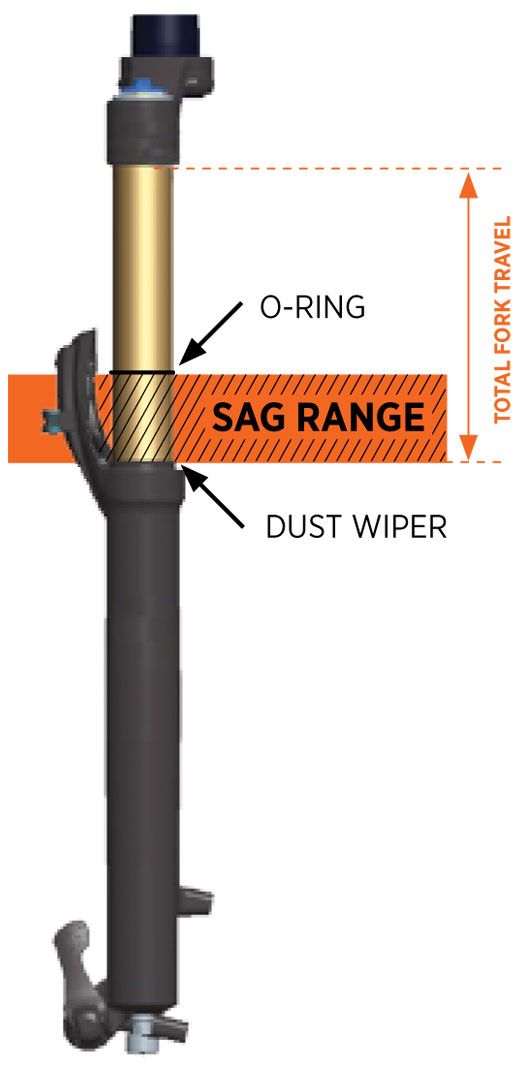
- Attach a FOX High Pressure Pump to the Schrader valve.
- Pump your fork to the appropriate pressure as listed in the 'Suggested starting points for setting sag' table below, then remove the pump.
- Using your forks sag setting o-ring on the left upper tube (or temporarily install a zip tie to the upper tube), slide the o-ring (or zip tie) down against the fork dust wiper. Rotate the compression lever to the Open mode (fully counter-clockwise).
- If you have a Remote fork, set the fork to Open mode.
- Dressed to ride (including a filled hydration pack, if you use one), position your bike next to a wall or table to support yourself. Mount your bicycle. Assume your riding position for at least 10 seconds, allowing the suspension to fully settle. Make sure you distribute your weight evenly between the saddle, handlebars and pedals.
- While in your riding position, slide the o-ring (or zip tie) down against the fork dust wiper.
- Dismount your bike without bouncing, to avoid further moving the o-ring or zip tie. Measure the distance between the dust wiper and the o-ring or zip tie. This is your sag measurement. Suggested sag measurements are listed in the table below.
- Add or remove air pressure until your sag measurement is between 15-20% of your forks total travel.
- Repeat steps 2-8 and recheck sag measurement.
- When sag measurement is correct, screw the air cap on clockwise until snug.
| Suggested Starting Points for Setting Sag- 32mm AX Forks | |||
| Rider Weight | Air Pressure | ||
| (lbs) | (kg) | (psi) | (bar) |
| 120-150 | 54-68 | 70-80 | 4.8-5.5 |
| 150-180 | 68-82 | 87-97 | 6.0-6.7 |
| 180-210 | 82-95 | 104-114 | 7.2-7.9 |
| 210-250 | 95-113 | 120-137 | 8.3-9.4 |
| Suggested Starting Points for Setting Sag- 32mm SC, FLOAT, and Rhythm Forks | |||
| Rider Weight | Air Pressure | ||
| (lbs) | (kg) | (psi) | (bar) |
| 120-150 | 54-68 | 65-74 | 4.5-5.1 |
| 150-180 | 68-82 | 80-90 | 5.5-6.2 |
| 180-210 | 82-95 | 96-106 | 6.6-7.3 |
| 210-250 | 95-113 | 111-126 | 7.6-8.7 |
| Suggested Starting Points for Setting Sag- 34mm SC, FLOAT, and Rhythm Forks | |||
| Rider Weight | Air Pressure | ||
| (lbs) | (kg) | (psi) | (bar) |
| 120-150 | 54-68 | 58-68 | 4.0-4.7 |
| 150-180 | 68-82 | 72-82 | 5.0-5.7 |
| 180-210 | 82-95 | 86-96 | 5.9-6.6 |
| 210-250 | 95-113 | 100-114 | 6.9-7.9 |
| Suggested Starting Points for Setting Sag- 34mm E-Bike+ | |||
| Rider Weight | Air Pressure | ||
| (lbs) | (kg) | (psi) | (bar) |
| 120-150 | 54-68 | 65-74 | 4.5-5.1 |
| 150-180 | 68-82 | 80-90 | 5.5-6.2 |
| 180-210 | 82-95 | 96-106 | 6.6-7.3 |
| 210-250 | 95-113 | 111-126 | 7.6-8.7 |
| Suggested Sag Measurements | ||
| Travel | 15% sag (Firm) | 20% sag (Plush) |
| 40mm/ 1.6 in (AX) | 6mm/ 0.2 in | 8mm/ 0.3 in |
| 80mm/ 3.1 in | 12mm/ 0.5 in | 16mm/ 0.6 in |
| 90mm/ 3.5 in | 13mm/ 0.5 in | 18mm/ 0.7 in |
| 100mm/ 3.9 in | 15mm/ 0.6 in | 20 mm/ 0.8 in |
| 110mm/ 4.3 in | 17mm/ 0.7 in | 22mm/ 0.9 in |
| 120mm/ 4.7 in | 18mm/ 0.7 in | 24mm/ 0.9 in |
| 130mm/ 5.1 in | 20 mm/ 0.8 in | 26mm/ 1.0 in |
| 140mm/ 5.5 in | 21mm/ 0.8 in | 28mm/ 1.1 in |
| 150mm/ 5.9 in | 23mm/ 0.9 in | 30mm/ 1.2 in |
| 160mm/ 6.3 in | 24mm/ 0.9in | 32mm/ 1.3 in |
Adjusting Rebound
Rebound controls how fast the fork extends after compressing
The rebound adjustment is dependent on the air pressure setting. For example, higher air pressures require more rebound damping.
Use your air pressure to find your rebound setting. Turn your rebound knob to the closed position (full clockwise) until it stops. Then
back it out (counter-clockwise) to the number of clicks shown in the table below.
| Suggested Rebound Settings- 32mm AX | |
| 32mm AX Air Pressure (psi/bar) | FIT4 Rebound |
| 70psi/ 4.8 bar | 12 |
| 76psi/ 5.2 bar | 11 |
| 81psi/ 5.6 bar | 10 |
| 87psi/ 6.0 bar | 9 |
| 95psi/ 6.5 bar | 8 |
| 104psi/ 7.2 bar | 7 |
| 108psi/ 7.4 bar | 6 |
| 112psi/ 7.7 bar | 6 |
| 116psi/ 8.0 bar | 5 |
| 120psi/ 8.3 bar | 4 |
| 126psi/ 8.7 bar | 3 |
| 132psi/ 9.1 bar | 2 |
| 137psi/ 9.4 bar | 1 |
| Suggested Rebound Settings- 32mm FLOAT SC | ||
| 32mm FLOAT SC Air Pressure (psi/ bar) | FIT4 Rebound | GRIP Rebound |
| 65psi/ 4.5 bar | 12 | 13 |
| 70psi/ 4.8 bar | 11 | 12 |
| 74psi/ 5.1 bar | 10 | 11 |
| 80psi/ 5.5 bar | 9 | 10 |
| 85psi/ 5.9 bar | 8 | 9 |
| 90psi/ 6.2 bar | 7 | 8 |
| 96psi/ 6.6 bar | 6 | 7 |
| 101psi/ 7.0 bar | 6 | 6 |
| 106psi/ 7.3 bar | 5 | 5 |
| 111psi/ 7.6 bar | 4 | 4 |
| 117psi/ 8.0 bar | 3 | 3 |
| 122psi/ 8.4 bar | 2 | 2 |
| 126psi/ 8.7 bar | 1 | 1 |
| Suggested Rebound Settings- 32mm FLOAT and Rhythm | ||
| 32mm FLOAT and Rhythm Air Pressure (psi/ bar) | FIT4 Rebound | GRIP Rebound |
| 65psi/ 4.5 bar | 8 | 13 |
| 70psi/ 4.8 bar | 8 | 12 |
| 74psi/ 5.1 bar | 7 | 11 |
| 80psi/ 5.5 bar | 7 | 10 |
| 85psi/ 5.9 bar | 6 | 9 |
| 90psi/ 6.2 bar | 6 | 8 |
| 96psi/ 6.6 bar | 5 | 7 |
| 101psi/ 7.0 bar | 5 | 6 |
| 106psi/ 7.3 bar | 4 | 5 |
| 111psi/ 7.6 bar | 4 | 4 |
| 117psi/ 8.0 bar | 3 | 3 |
| 122psi/ 8.4 bar | 2 | 2 |
| 126psi/ 8.7 bar | 1 | 1 |
| Suggested Rebound Settings- 34mm FLOAT SC | ||
| 34mm FLOAT SC Air Pressure (psi/ bar) | FIT4 Rebound | GRIP Rebound |
| 65psi/ 4.5 bar | 12 | 13 |
| 70psi/ 4.8 bar | 11 | 12 |
| 74psi/ 5.1 bar | 10 | 11 |
| 80psi/ 5.5 bar | 9 | 10 |
| 85psi/ 5.9 bar | 8 | 9 |
| 90psi/ 6.2 bar | 7 | 8 |
| 96psi/ 6.6 bar | 6 | 7 |
| 101psi/ 7.0 bar | 6 | 6 |
| 106psi/ 7.3 bar | 5 | 5 |
| 111psi/ 7.6 bar | 4 | 4 |
| 117psi/ 8.0 bar | 3 | 3 |
| 122psi/ 8.4 bar | 2 | 2 |
| 126psi/ 8.7 bar | 1 | 1 |
| Suggested Rebound Settings- 34mm FLOAT and Rhythm | ||
| 34mm FLOAT and Rhythm Air Pressure (psi/ bar) | FIT4 Rebound | GRIP Rebound |
| 65psi/ 4.5 bar | 8 | 13 |
| 70psi/ 4.8 bar | 8 | 12 |
| 74psi/ 5.1 bar | 7 | 11 |
| 80psi/ 5.5 bar | 7 | 10 |
| 85psi/ 5.9 bar | 6 | 9 |
| 90psi/ 6.2 bar | 6 | 8 |
| 96psi/ 6.6 bar | 5 | 7 |
| 101psi/ 7.0 bar | 5 | 6 |
| 106psi/ 7.3 bar | 4 | 5 |
| 111psi/ 7.6 bar | 4 | 4 |
| 117psi/ 8.0 bar | 3 | 3 |
| 122psi/ 8.4 bar | 2 | 2 |
| 126psi/ 8.7 bar | 1 | 1 |
Adjust rebound until when tested, the fork returns quickly but does not top out.
Top out is felt when a fork fully extends too quickly and comes to an abrupt stop when it reaches full extension (you will hear/feel a small noise). Top out should be avoided through proper rebound setting.
Adjusting FIT4 Compression Damping
Easy on-the-fly adjustments for unprecedented control and performance
3-Position Lever: The 3-position lever is useful to make on-the-fly adjustments to control shock performance under significant changes in terrain, and is intended to be adjusted throughout the ride. You can use the OPEN mode during rough descending, the MEDIUM mode for undulating terrain, and the FIRM mode for smooth climbing.
FOX recommends beginning with the 3-position lever in the open mode.
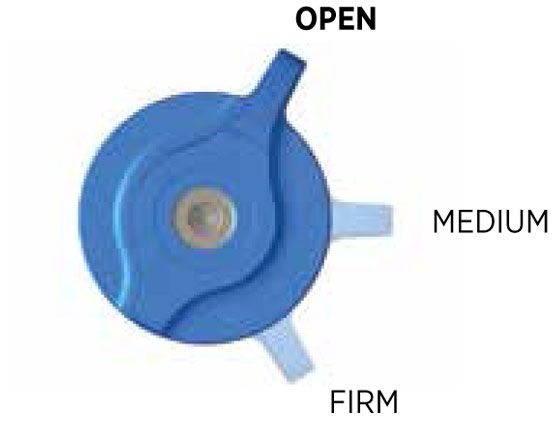
*OPEN Mode Adjust: Open mode adjust is useful to control fork performance under rider weight shifts, G-outs, and slow inputs. OPEN mode adjust provides 22 additional fine tuning adjustments for the OPEN mode. Setting 22 will have a more plush feel and setting 1 will have a firmer feel.
FOX recommends beginning with the Open mode adjust set to 18 clicks out (counter-clockwise) from fully closed (clockwise).
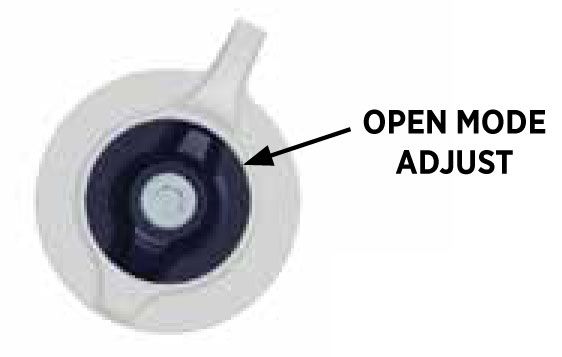

*Factory and Performance Elite Series forks only.
Adjusting GRIP Compression Damping
3-Position Micro Adjust: The 3-position lever is useful to make on-the-fly adjustments to control fork performance under significant changes in terrain, and is intended to be adjusted throughout the ride. Turning the lever to the full counter-clockwise position sets the fork in the Open mode. Turning the lever to the middle detent position sets the fork in the Medium mode. Turning the lever to the full clockwise position sets the fork in Firm mode. The positions between the Open, Medium, and Firm modes can be utilized to fine tune your compression damping.
FOX recommends beginning with the 3-position lever in the Open mode.
2-Position Sweep Adjust (Rhythm Forks Only): The 2-position lever is useful to make on-the-fly adjustments to control fork performance under significant changes in terrain, and is intended to be adjusted throughout the ride. Turning the lever to the full counter-clockwise position sets the fork in the Open mode. Turning the lever to the full clockwise position sets the fork in Firm mode. The positions between the Open and Firm modes can be utilized to fine tune your compression damping.
FOX recommends beginning with the 2-position lever in the Open mode.
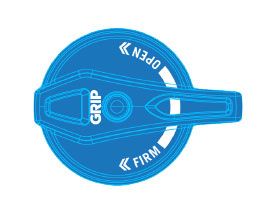
Remote Installation
The 2-Position remote can either be installed under the handlebar on the non-drive side, where a front shifter would typically be placed, or installed above the handlebar on the drive side. The 2-Position remote can be used with two cables to control both Push-to-Unlock forks and shocks simultaneously. The 3-Position remote can be installed in-line with the handlebar on either side and can control the fork or shock.
FIT4 DAMPERS (Push-to-Lock and Push-to-Unlock)
- Install the remote lever onto your handlebar. Do not exceed 1.7 Nm (15 in-lb). Less torque may be needed for carbon bars. Refer to the handlebar manufacturer’s instructions for use with carbon bars. Make sure to check for clearance between the remote lever and any brake or shifter controls.
- For Push-to-Lock forks only - route the cable housing from the remote lever, around the rear of the crown, to the fork topcap cable stop and cut to length. Install a ferrule on the remote end.
- For Push-to-Unlock forks only – route the cable housing from the remote lever, across the front of the crown, to the fork topcap cable stop and cut to length. Install ferrules on both ends.
- Set the remote lever to OPEN mode by pushing the release lever. Make sure that the cable head is completely seated in the remote lever.
- For 2-Position remotes only - use a short piece of housing with one ferrule between the in-line barrel adjuster and the remote lever body.
- With all cable housing fully seated and no slack in the system, lightly lubricate the inner cable and thread it through the cable housing and around the fork remote pulley.
- While holding the cable tight, tighten the pinch bolt, cut off excess cable, and crimp the end.
GRIP DAMPERS (Push-to-Lock only)
- Install the remote lever onto your handlebar. Do not exceed 1.7 Nm (15 in-lb). Less torque may be needed for carbon bars. Refer to the handlebar manufacturer’s instructions for use with carbon bars. Make sure to check for clearance between the remote lever and any brake or shifter controls.
- Route the cable housing from the fork topcap, around the rear of the crown, to the remote lever and cut to length. Install a ferrule on the end of the housing at the remote lever. The end of the housing at the fork topcap does not require a ferrule.
- For 2-Position remotes only - use a short piece of housing with one ferrule between the in-line barrel adjuster and the remote lever body.
- Set the remote lever to FIRM mode by pushing the actuation lever. Make sure that the cable head is completely seated in the remote lever.
- Use a 5 mm hex wrench to turn the remote pulley clockwise until you feel it lightly stop, then hold it in place. For forks with the cable exiting the topcap at the rider’s 1 o’clock position: the remote pulley should stop at the 10-11 o’clock position. For forks with the cable exiting the topcap at the rider’s 7 o’clock position: the remote pulley should stop at the 4-5 o’clock position.
- With all cable housing fully seated and no slack in the system, lightly lubricate the inner cable and thread it through the cable housing and around the fork remote pulley. While gently holding the remote pulley against the clockwise stop with your 5 mm hex wrench, tighten the pinch bolt.
- Release the 5 mm hex wrench from the remote pulley, cut off the excess inner cable, and crimp the end.
- The in-line barrel adjuster may be used to change the lockout blow-off force. Clockwise barrel adjustment increases blow-off force, while counter-clockwise adjustment decreases blow-off force.
Using the 2-Position Remote
The 2-position remote is designed to be used in place of a front shifter, under the handlebar on the rider's left side. The 2-position remote can be used with 2 cables to control both the front fork and rear shock simultaneously.
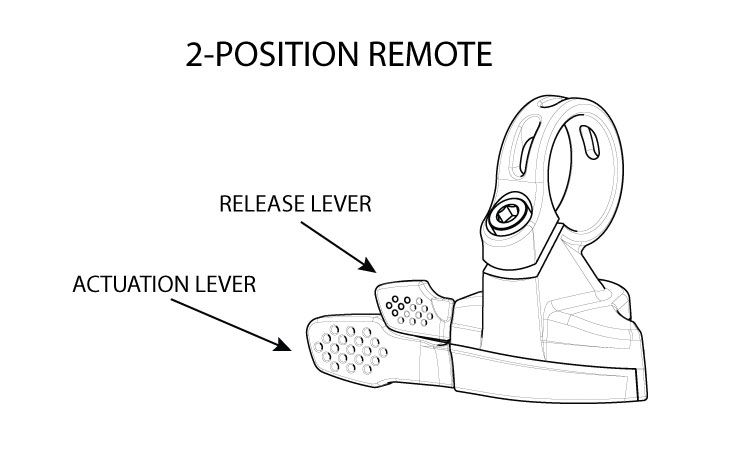
The 2-Position Remote lets you to switch between the OPEN and FIRM modes while riding.
- Push-to-Lock – Push the actuation lever to set the fork to FIRM mode. Push the release lever to set the fork to OPEN mode.
- Push-to-Unlock – Push the actuation lever to set the fork to OPEN mode. Push the release lever to set the fork to FIRM mode.
Using the 3-Position Remote
The 3-Position Remote lets you to switch between the OPEN, MEDIUM, and FIRM modes while riding.
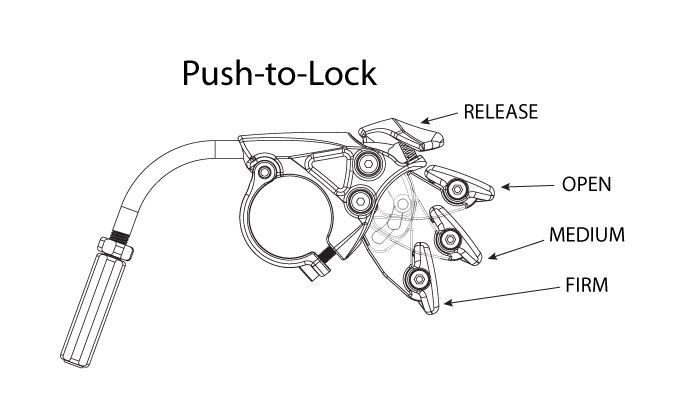
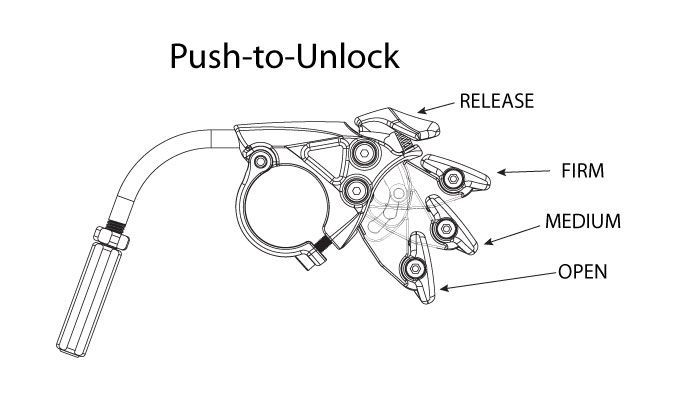
- Push-to-Lock – Push the actuation lever down one click to set the fork to MEDIUM mode. Push the actuation lever down again to the lowest position to set the fork to FIRM mode. Push the release lever to set the fork to OPEN mode.
- Push-to-Unlock – Push the actuation lever down one click to set the fork to MEDIUM mode. Push the actuation lever down again to the lowest position to set the fork to OPEN mode. Push the release lever to set the fork to FIRM mode.
Tuning with Air Volume Spacers (FLOAT and RHYTHM forks only)
Changing volume spacers in the 32/34 FLOAT and RHYTHM forks is an easy internal adjustment that allows you to change the amount of mid stroke and bottom out resistance.
-
If you have set your sag correctly and are using full travel (bottoming out) too easily, then you could install one or more spacers to increase bottom out resistance.
-
If you have set your sag correctly and are not using full travel, then you could remove one or more spacers to decrease bottom out resistance.
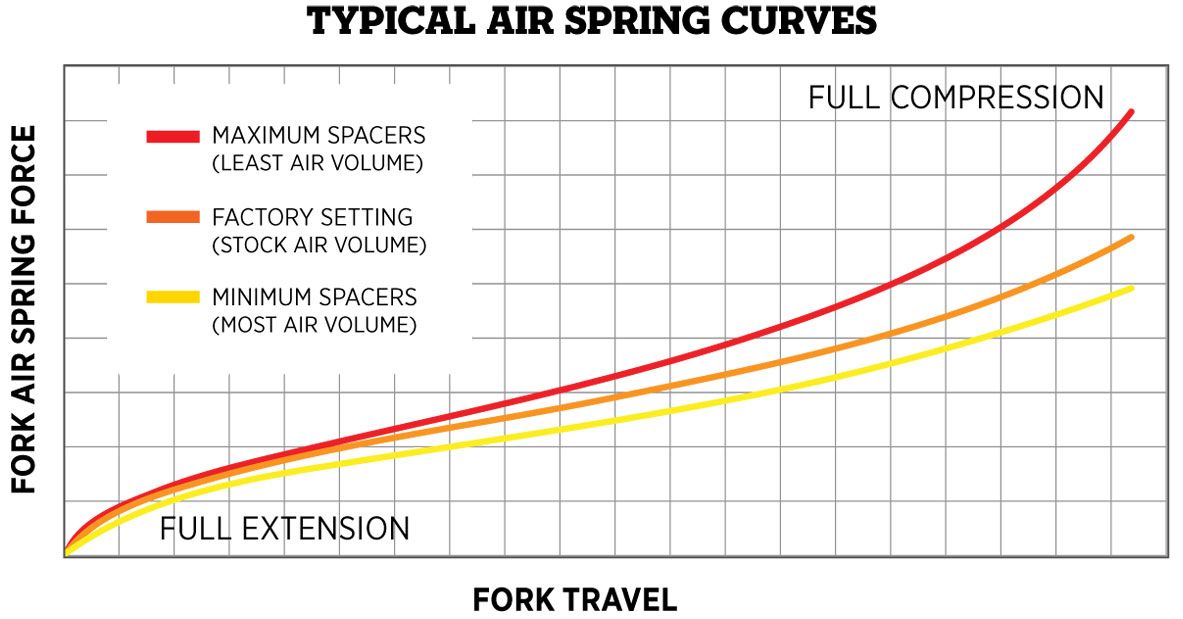
| 32 Step Cast FLOAT Volume Spacer Configuration | ||
| Travel | Volume Spacers Factory Installed | *Max Volume Spacers |
| 100 mm | 2 | 4 |
| 80 mm | 2 | 4 |
| 40 mm (AX) | 5 | 7 |
| 32 FLOAT Volume Spacer Configuration | ||
| Travel | Volume Spacers Factory Installed | *Max Volume Spacers |
| 140 mm | 2 | 5 |
| 130 mm | 3 | 6 |
| 120 mm | 1 | 4 |
| 110 mm | 2 | 4 |
| 100 mm | 2 | 4 |
| 90 mm | 2 | 4 |
| 80 mm | 3 | 5 |
| 32 27.5 Rhythm and 32 29 Rhythm 15x110 Volume Spacer Configurations | ||
| Travel | Volume Spacers Factory Installed | *Max Volume Spacers |
| 120mm | 0 | 4 |
| 110mm | 0 | 4 |
| 100mm | 1 | 5 |
| 80mm | 2 | 6 |
| 32 29 Rhythm QR9 Volume Spacer Configurations | ||
| Travel | Volume Spacers Factory Installed | *Max Volume Spacers |
| 120mm | 2 | 6 |
| 110mm | 3 | 6 |
| 100mm | 4 | 7 |
| 80mm | 5 | 8 |
| 34 Step Cast FLOAT Volume Spacer Configuration | ||
| Travel | Volume Spacers Factory Installed | *Max Volume Spacers |
| 120 mm | 2 | 4 |
| 110 mm | 3 | 5 |
| 100 mm | 4 | 5 |
| 34 FLOAT Volume Spacer Configuration | ||
| Travel | Volume Spacers Factory Installed | *Max Volume Spacers |
| 160 mm | 1 | 4 |
| 150 mm | 2 | 5 |
| 140 mm | 2 | 5 |
| 130 mm | 3 | 6 |
| 120 mm | 5 | 6 |
| 110 mm | 6 | 7 |
| 34 Rhythm Volume Spacer Configuration | ||
| Travel | Volume Spacers Factory Installed | *Max Volume Spacers |
| 150 mm | 0 | 4 |
| 140 mm | 0 | 4 |
| 130 mm | 1 | 5 |
| 120 mm | 2 | 5 |
| 110 mm | 3 | 6 |
| 100 mm | 4 | 6 |
| 34 E-Bike+ Volume Spacer Configuration | ||
| Travel | Volume Spacers Factory Installed | *Max Volume Spacers |
| 150 mm | 2 | 5 |
| 140 mm | 3 | 5 |
| 130 mm | 4 | 6 |
| 120 mm | 4 | 7 |
| 110 mm | 5 | 7 |
| 100 mm | 6 | 8 |
| 90 mm | 6 | 8 |
| 80 mm | 6 | 9 |
*DO NOT EXCEED THE MAXIMUM NUMBER OF VOLUME SPACERS LISTED ABOVE!
The 32mm FLOAT, FLOAT SC, and AX volume spacer PN: 234-04-811 is blue and has a volume of 8cc
The 32mm Rhythm volume spacer is PN: 234-04-735 is pink and has a volume of 8cc
The 34mm FLOAT, FLOAT SC, and Rhythm volume spacer PN: 234-04-953 is green and has a volume of 10cc
34mm E-Bike+ Volume Spacer PN: 234-04-811 is blue and has a volume of 8cc
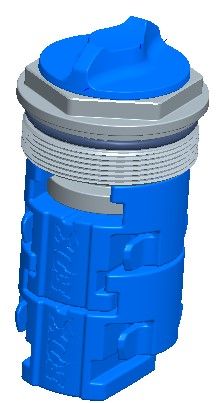
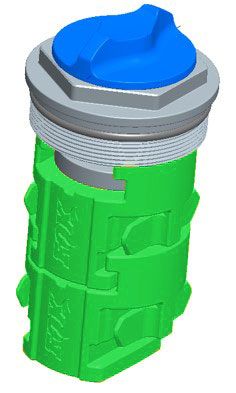
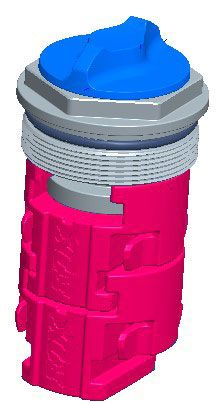
Some 32mm FLOAT forks come with a factory installed hollow volume spacer pictured below. Standard blue 32mm volume spacers can be added to the hollow volume spacer to further reduce air volume if desired.
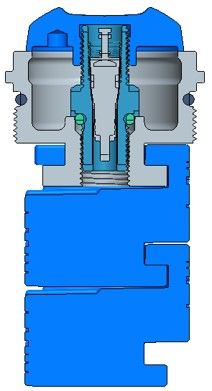
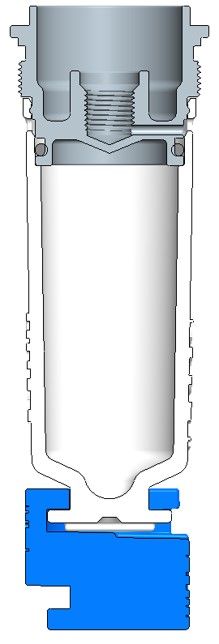

For air volume spacer installation and removal instructions, please visit: 2016 32mm/34mm FLOAT Air Spring Tuning with Air Volume Spacers »
WARNING: Never attempt to modify air volume spacers, as this can damage your fork causing a loss of control of the bicycle leading to SERIOUS INJURY or DEATH.
WARNING: FOX suspension products contain pressurized nitrogen, air, oil, or all 3. Suspension misuse can cause property damage, SERIOUS INJURY OR DEATH. DO NOT puncture, incinerate or crush any portion of a FOX suspension product. DO NOT attempt to disassemble any portion of a FOX suspension product, unless expressly instructed to do so by the applicable FOX technical documentation, and then ONLY while strictly adhering to all FOX instructions and warnings in that instance.
WARNING: Modification, improper service, or use of aftermarket replacement parts with FOX forks and shocks may cause the product to malfunction, resulting in SERIOUS INJURY OR DEATH. DO NOT modify any part of a fork or shock, including the fork brace (lower leg cross brace), crown, steerer, upper and lower leg tubes, or internal parts, except as instructed herein. Any unauthorized modification may void the warranty, and may cause failure or the fork or shock, resulting in SERIOUS INJURY OR DEATH.
Service Intervals
Make sure to properly maintain your fork
To best maintain the performance and durability of your product under normal use, FOX recommends that you have regular fork and shock maintenance performed according to the service intervals listed below.

*Suspension product will require more frequent servicing the harder they are worked. For those who ride lift-accessed DH, Park, or Extreme Freeride or in extremely wet/muddy or dry/dusty environmental conditions where trail debris is sprayed onto the fork or shock while on the trail, or e-mtb's, FOX encourages riders to perform maintenance earlier than recommended above as needed. If you hear, see, or feel something unusual, stop riding immediately and contact a FOX Authorized Service Center for proper servicing.
